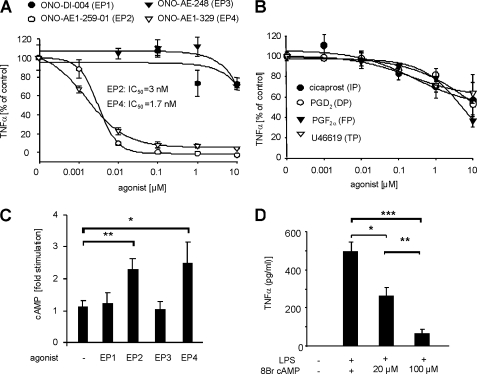FIGURE 1.
Anti-inflammatory properties of PGE2 are mediated through EP2 and EP4 in primary spinal cord cultures. A, effects of different EP receptor agonists on LPS-induced TNFα release from spinal cultures. Cells were incubated with 1 μg/μl LPS and the respective agonist concentrations for 3 h. TNFα concentrations were determined in the culture supernatants by EIA. Data are shown as mean ± S.E. (error bars) of 3–6 experiments. B, same as D except that agonists for IP, DP, FP, and TP receptors were used. Data are shown as mean ± S.E. of 3–6 experiments. C, EP agonist-stimulated cAMP synthesis in primary spinal cord cultures. Cells were preincubated with 0.1 μm isobutylmethylxanthine for 5 min and then stimulated with 0.1 μm ONO-DI-004 (EP1) ONO-AE1-259-01 (EP2), ONO-AE-248 (EP3), or ONO-AE1-329 (EP4) for 15 min. Data are shown as mean ± S.E. of at least 6 experiments. Student's t test: *, p ≤ 0.05; **, p ≤ 0.01. D, TNFα release from LPS-stimulated primary spinal cord cultures. Embryonic spinal cord cultures were incubated with 1 μg/ml LPS and the respective concentration of 8-bromo-cAMP (8Br cAMP) for 3 h. Data shown represent the mean ± S.E. (n = 3). Student's t test: *, p ≤ 0.01; **, p ≤ 0.005; ***, p ≤ 0.001.

